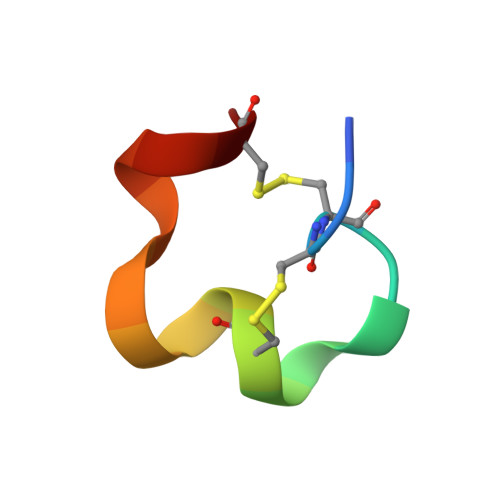Structure-Function Elucidation of a New alpha-Conotoxin, Lo1a, from Conus longurionis.
Lebbe, E.K., Peigneur, S., Maiti, M., Devi, P., Ravichandran, S., Lescrinier, E., Ulens, C., Waelkens, E., D'Souza, L., Herdewijn, P., Tytgat, J.(2014) J Biol Chem 289: 9573-9583
- PubMed: 24567324
- DOI: https://doi.org/10.1074/jbc.M114.556175
- Primary Citation of Related Structures:
2MD6 - PubMed Abstract:
α-Conotoxins are peptide toxins found in the venom of marine cone snails and potent antagonists of various subtypes of nicotinic acetylcholine receptors (nAChRs). nAChRs are cholinergic receptors forming ligand-gated ion channels in the plasma membranes of certain neurons and the neuromuscular junction. Because nAChRs have an important role in regulating transmitter release, cell excitability, and neuronal integration, nAChR dysfunctions have been implicated in a variety of severe pathologies such as epilepsy, myasthenic syndromes, schizophrenia, Parkinson disease, and Alzheimer disease. To expand the knowledge concerning cone snail toxins, we examined the venom of Conus longurionis. We isolated an 18-amino acid peptide named α-conotoxin Lo1a, which is active on nAChRs. To the best of our knowledge, this is the first characterization of a conotoxin from this species. The peptide was characterized by electrophysiological screening against several types of cloned nAChRs expressed in Xenopus laevis oocytes. The three-dimensional solution structure of the α-conotoxin Lo1a was determined by NMR spectroscopy. Lo1a, a member of the α4/7 family, blocks the response to acetylcholine in oocytes expressing α7 nAChRs with an IC50 of 3.24 ± 0.7 μM. Furthermore, Lo1a shows a high selectivity for neuronal versus muscle subtype nAChRs. Because Lo1a has an unusual C terminus, we designed two mutants, Lo1a-ΔD and Lo1a-RRR, to investigate the influence of the C-terminal residue. Lo1a-ΔD has a C-terminal Asp deletion, whereas in Lo1a-RRR, a triple-Arg tail replaces the Asp. They blocked the neuronal nAChR α7 with a lower IC50 value, but remarkably, both adopted affinity for the muscle subtype α1β1δε.
Organizational Affiliation:
From Toxicology and Pharmacology, University of Leuven (KU Leuven), Campus Gasthuisberg, O&N2, 3000 Leuven, Belgium.














